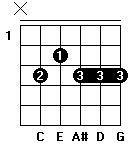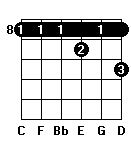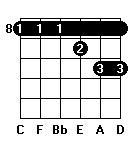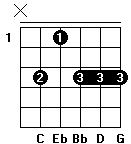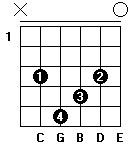Extended Chords(lesson)
So far we have looked at triads made by stacking 3rd notes on top of each other, then we took it a step further and added a 4th note to get some flavour of 7th chord. So, what do we get if we take this notion of adding 3rds to the next level? Well we can carry on doing this to create a family of what are called "extended chords" - and some of them are beautiful sounding and quite jazzy chords. We'll have a look at these Extended chords in this lesson.
Taking it Past the Octave
One thing to notice about about our triads and seventh chords is that all of the notes are part of the same octave. When we start to move past a seventh, when adding a 3rd interval on top, we step outside of our first octave and into the second. There is nothing particularly scary about this but it does have naming implications. Lets look at an example.
Lets start with a chord of C7:
C E G Bb
If we want to move a step further and create an extended chord out of this by stacking another 3rd on top, staying with in the scale we would add a D note in to get:
C E G Bb D
Now as you will all be aware from our earlier study on intervals, D is a 2nd interval to our root note of C, but in this case its is an octave higher than out second, so we refer to it as a 9th (that is the 2nd interval that D normally is, plus the 7 distinct intervals in the lower octave). In fact, when we move past the octave in this way, the interval is called a compound interval. The 9th we have described here is also known as a compound 2nd. So, the chord I showed you above is in fact called C9, and you could play it like this:
Elevenths and Thirteenths
We can continue our process of adding 3rds and go 2 steps further - adding an 11th and a 13th. By the time we get here though, we are playing 6 and 7 notes in our chord. The 13th is particularly interesting because it contains every note in the diatonic scale in one chord.
C11 would be C E G Bb D F
and C13 would be C E G Bb D F A
With 6 notes in an 11th, its just possible to arrange all of these on a guitar fretboard when playing a C11 for instance:
Since we only have 6 strings, we can never play the full version of a 13th on a guitar (instruments like a piano can however). Instead it is customary for extended chords to miss out the 5th, and intervening intervals between the 7th and the highest note. For instance, you could play a 13th chord that omits the 5th, 9th and 11th. This moves us into the real of chord voicings; which particular combination of notes you choose to play a particular extended chord can have an effect on how the overall piece sounds. Here are a couple of examples of how you might voice a 13th chord on a guitar. First, we'll omit the 5th and leave in the 9th and 11th:
As an alternative C13 voicing, we would put the 5th back in and omit the 9th and 11th:
Extended Majors Minors and Sevenths
As you know, the major and minor characteristic of a chord is about its most important attribute, followed by the flavour of seventh it has. The extended chords that we have seen so far are always based on a chord that has a major 3rd and a minor or Dominant 7th. With that as a basis we can stack notes on top to get our basic extended chords, and then we can use the same variations of 3rd and 7th that we have previously discussed to get different flavours of extended chords.
For instance, if we flatten the 3rd of a 9th chord, we end up with a minor 9th. Here is an example of Cm9:
Notice that we now have an Eb in there - a minor 3rd.
And finally, we can make changes to the dominant 7th and make use of a major 7th in its place and end up with a Major 7 9th - for instance Cmaj79:
Our 3rd is now a Major 3rd again (E) and we have raised our major 7th (Bb) to a B.
Its also possible to use for instance a minor 3rd and a major 7th (based on our friend the Minor Major 7th chord) and add the 9th to obtain a minor major 7 9 - some of these more obscure chords aren't particularly musical but they are there if you need them.
That wraps it up for extended chords - any comments or questions in the forum as usual.



